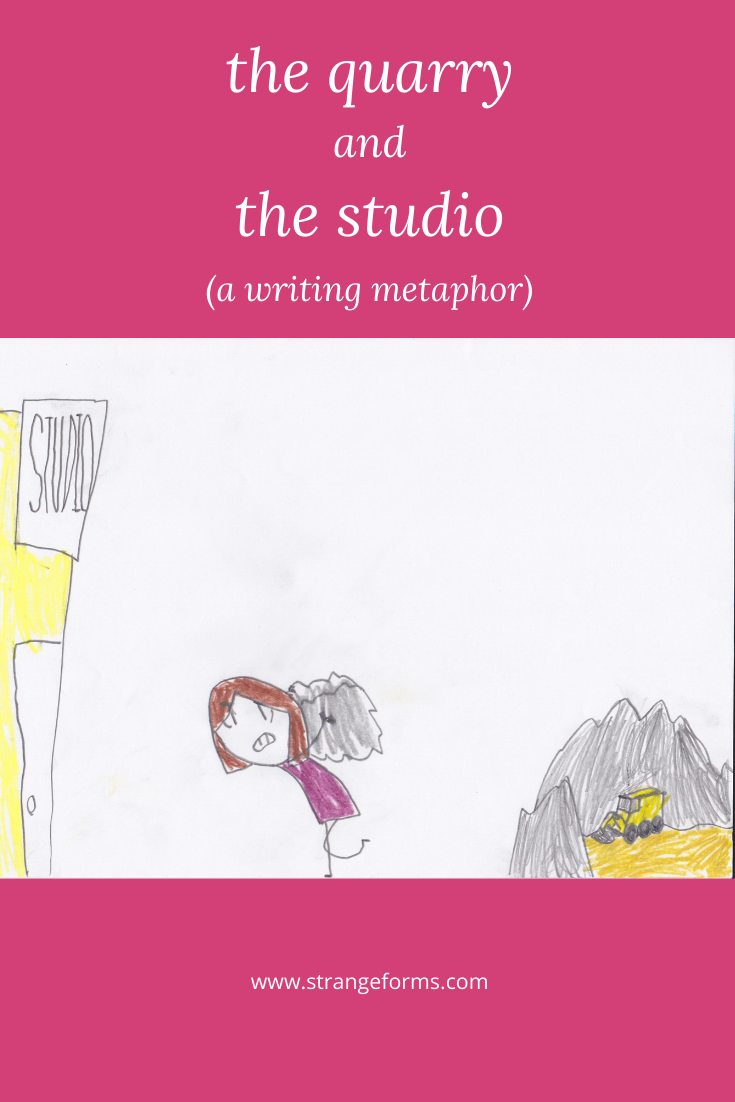I’m slowly getting back to working on my novel draft at the moment, so I’ve been thinking about this writing metaphor I came up with many years ago. I use it to describe the difference between drafting and editing — to try to pin down why the skills required for these two activities are so different, and why drafting can be so very hard.
Maybe it’ll resonate for you too.
(I suppose the metaphor might also apply to sketching, sampling, prototyping, workshopping, and other analogous techniques, but I mostly find it useful in thinking about writing. I’d love to hear your thoughts on that, if you think it speaks to your particular discipline.)
Here’s how it goes.
You head to the quarry in the morning to cut your stone. You work hard through the heat of the day, digging and blasting, wedging and splitting, sweat dripping unheeded from your brow and running salty channels down your dust-filmed skin.
(Get a load of you and your sun-bronzed, taut-muscled body, there. Mmmm.)
At the end of your labours, you have extracted a lump of stone, roughly shaped, roughly sized, unfinished.
You drag it back to your studio and you stumble, exhausted, into your bed.
That lump of stone?
That’s your draft.
Next morning, in your studio, you set to work with your chisels and your hammers, your drills and your picks, chipping and grinding, rounding and polishing, standing back to see the effect of the light on your work, darting in again to make an adjustment.
That’s the editing process, and it is a very different undertaking from the production of the draft.
Different tools, different methods, different challenges. (I have a whole different metaphor for it, too, which I’ll explore in another post.)
These tasks have an optimal order.
With the best will in the world, you can’t carve a piece of stone that hasn’t been quarried yet.
Moreover, there’s not much point in working detail into your lump when it’s still only halfway out of the mountainside.
And for goodness sake, please don’t use dynamite in the studio, or you’ll never hear the end of it from the Elfin Safety.
The takeaway here: quarry first, then carve.
Personally, I much prefer editing to drafting.
Having material in front of me to work with feels far easier than making something appear where nothing was before.
So when I draft, I have to use sneaky tactics to stop myself from drifting into the chiselling and polishing parts of the work and keep myself focused on that bloody mountainside.
Here are some tactics I use, for anyone who may be interested:
- Working out of order, on whatever scene most excites me right now.
- Drawing up scenes in bullet points before drafting them.
- Working in timed sessions, typing as fast as I can, without stopping.
- Using dictation software, and working with my eyes closed.
- Leaving curly-bracketed notes for myself when I need to research something, rather than breaking off to look it up there and then.
- Using a spreadsheet to track my progress and motivate myself to keep at it.
It’s not a perfect metaphor, obviously.
Drafting a long piece of fiction can involve rewriting the same material many times, for instance, or completely rearranging the structure, or adding large chunks that weren’t in the original lump at all. Harder to do that with stone.
Also, sometimes it feels like the quarry is not a mountainside, precisely, but rather your guts, into which you’re digging with a rusty spoon.
But there’s definitely something there.
Something about the rhythm of the work — it’s good to let yourself build up momentum by quieting that second-guessing editor voice and just thumping away until you dislodge something usable from your brain.
This is where many writers find that they surprise themselves: fresh, sparky ideas emerge in the moment that they didn’t consciously invent.
That sort of magic can only happen if you get out of your own way and let your fiction-quarrying tools swing freely in the breeze.
The attitude is the important part.
When you’re drafting, do drafting.
Let the work come as it comes, in a rough-hewn lump, rudely hauled out of the mountain.
Leave the editing until later, when you know what you’re dealing with.
At the very least, you’ll save yourself a lot of pain.
